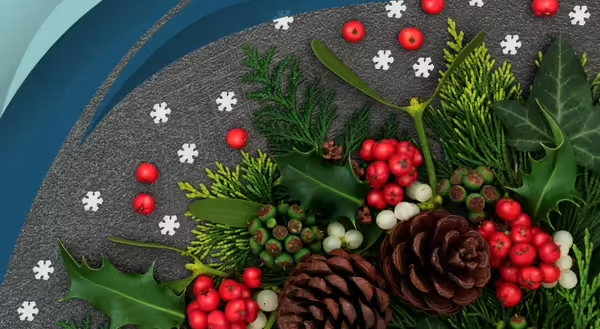
During the holidays, there are a few plants that seem ubiquitous, even if only during the month of December. But have you ever wondered why we “deck the halls with boughs of holly” or kiss under the mistletoe?
Holly
Holly (Ilex sp.) is a group of almost 500 species of both deciduous and evergreen plants – mostly shrub and shrub-like trees – with members all over the world. Here in Illinois, three species are native, Ilex opaca (American Holly), Ilex verticilata (Winterberry), and Ilex decidua (Possumhaw). All three can be used in home landscaping with bright red berries for nice winter interest, but only American Holly is evergreen and looks like the traditional Christmas Holly, which typically features its English cousin. Holly plants are dioecious (having separate male and female plants), so if you would like to have berries in the winter, both male and female plants must be planted.
The use of holly in the winter is a tradition that dates back to ancient European cultures. Druids and Romans used holly for decoration, as it retained its pretty green leaves and red berries at a time when everything else was brown and dead. Decorating with holly was said to protect homes, as the prickly leaves would snag evil spirits, preventing them from entering the home. Even in more recent times, holly is said to bring luck, fertility, and protection to those who adorned themselves and their homes with this beautiful plant.
Mistletoe
Mistletoe is a semi-parasitic plant. This means that as it grows, it attaches itself to a host plant (usually a tree) and while it can photosynthesize, it also steals water and nutrients from the host. (Much like a holiday guest who won’t leave!) It produces small white berries, which are eaten by birds, who then go on to spread the seeds.
The history of using mistletoe as a decoration in the winter again takes us back to ancient civilizations. Druids saw it as a symbol of vitality as it bloomed in the harsh winter. Additionally, in Norse mythology, the god Baldur was killed by an arrow made out of mistletoe. However, Baldur was able to be resurrected, and in her joy, his mother Frigg declared it to be a symbol of love. At some point in the Middle Ages, it was incorporated into Christmas celebrations and servants began the custom of stealing a kiss under the mistletoe. According to the custom, if a woman refused the kiss, it would mean bad luck (and no marriage proposals) for the year.
So, this year, as we hunker down in our homes, lamenting the sun setting before dinner, consider bringing a little reminder of the liveliness of summer indoors. Celebrate the changing of the seasons with some bright green and red holly or some mischievous mistletoe.
References and more information
“Before Stealing a Kiss, Learn the Mythology and History of Mistletoe.” Fort Worth Botanic Garden. Accessed 12/12/23.
“Why Do We Kiss Under the Mistletoe?” History.com. Accessed 12/12/23.
“Mistletoe: The Evolution of a Christmas Tradition.” Smithsonian Magazine. Accessed 12/12/23.
“Plant of the Winter Solstice: Holly.” Cornell Botanic Gardens. Accessed 12/12/23.
About the author: Jamie Viebach is the University of Illinois Extension Horticulture Educator serving DuPage, Kane, and Kendall counties. Viebach’s primary areas of expertise are native plants, landscaping, pollinators, and rain gardens.